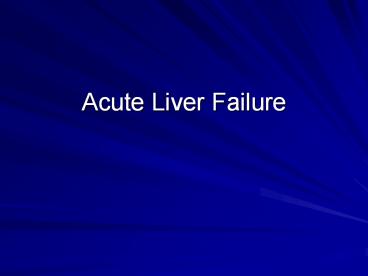Acute Liver Failure - PowerPoint PPT Presentation
1 / 20
Title:
Acute Liver Failure
Description:
Acute Liver Failure 30 year old woman presents to hospital with a two day history of nausea, vomiting, and right upper quadrant pain. She has been healthy and denies ... – PowerPoint PPT presentation
Number of Views:679
Avg rating:3.0/5.0
Title: Acute Liver Failure
1
Acute Liver Failure
2
- 30 year old woman presents to hospital with a two
day history of nausea, vomiting, and right upper
quadrant pain. - She has been healthy and denies any medication
use. - She recently traveled to Vietnam where she
twisted her ankle while bungee jumping. The pain
has been well controlled with over the counter
and natural remedies.
3
- On examination, she is slightly confused to date
and in moderate distress from the pain. - Vital signs are 123/41, heart rate 109,
respiratory rate 24, and saturations 95 on room
air. - She is has diffuse abdominal tenderness and
palpable liver edge with a scleral icterus.
4
- What is the most likely cause of this patients
presentation? - What are the common etiologies of acute liver
failure? - Consider
- A acetaminophen, hepatitis A, autoimmune
- B hepatitis B
- C cryptogenic, hepatitis C
- D hepatitis D
- E esoteric causes such as Wilsons and
Budd-Chiari - F fatty infiltration such as fatty liver of
pregnancy and Reye
5
- Initial bloodwork comes back
- ALT 3826, AST 4826, TBili 59, Alk Phos 283,INR
4.2, creatinine 436, pH 7.31 - What in the history gives us clues to the cause?
- Travel hepatitis virus?
- Over the counter drugs acetaminophen?
- Natural remedies drug or toxin?
- Childbearing age fatty liver of pregnancy?
6
- Obtaining further history, her family tells you
that she has been vaccinated against hepatitis B
because she is a lab tech, she is not pregnant
but do not know what medications and remedies she
takes. - You take the history from the family because the
patient is rapidly becoming unresponsive.
7
- What is the definition of fulminant hepatic
failure? - Severe acute liver injury with impaired synthetic
function and encephalopathy in a person with a
normal liver or well-compensated liver disease. - What are the grades of encephalopathy?
- The patient has become completely unresponsive
with posturing to stimulation. You rapidly
intubate and resuscitate her and obtain an urgent
CT scan.
8
Head CT
9
- What has happened?
- How do you grade hepatic encephalopathy?
10
(No Transcript)
11
- How do you treat hepatic encephalopathy with and
without intracranial hypertension? - What is the role for intracranial monitoring in
this case?
12
- After appropriate resuscitation and treatment,
the patient is more stable. The family
approaches you for more information. They want
to know whether she is going to need liver
transplant. - What do you tell them and how do you know?
13
(No Transcript)
14
By the way, what are some of the drugs that can
cause fulminant hepatic failure?
- Acetaminophen
- Alcohol
- Amiodarone
- Carbon tetrachloride
- Dideoxyinosine
- Gold
- Halothane
- Isoniazid
- Ketoconazole
- MAO inhibitors
- Methyldopa
- NSAIDs
- Phenytoin
- Poison mushrooms (Amanita phalloides)
- Propylthiouracil
- Rifampin
- Sulfonamides
- Tetracycline
- Tricyclic antidepressants
15
Next patient
- 68 year old man with known chronic liver
dysfunction from NASH. - He presents to his family doctor with increasing
confusion. He admits the patient to hospital and
consults you because of persisting fevers. - On assessment, he is febrile, slightly jaundiced
with signs of chronic liver disease and abdominal
tenderness. - Blood cultures come back positive for E. coli
16
- What is the most likely problem?
- How is the diagnosis of spontaneous bacterial
peritonitis made? - A paracentesis reveals a WBC count of 375
cells/mL with 95 PMNs. - What is the appropriate treatment of spontaneous
bacterial peritonitis?
17
- The next day, the patient feels better but his
urine output has been poor. - His creatinine is 242, last level 6 months ago
was 109. - What are the possible causes of this problem?
- Consider
- Volume depletion from paracentesis
- Abdominal compartment syndrome
- ATN from nephrotoxins such as aminoglycosides
- Interstitial nephritis from B-lactams
- Hepatorenal syndrome
- How would you investigate this?
18
- There is no change in renal function after fluid
challenges and his urine sodium is lt 10 mmol/L. - What is the criteria for hepatorenal syndrome?
- What is the pathophysiology behind hepatorenal
syndrome?
19
- The diagnosis of HRS is confirmed. The family
asks you what this means. He has refused
transplant workup and long term dialysis. - What do you tell the family?
- What is the role of albumin in HRS?
- What is the role of vasopressors such as
midodrine/octreotide or levophed/vasopressin in
HRS?
20
Questions??

